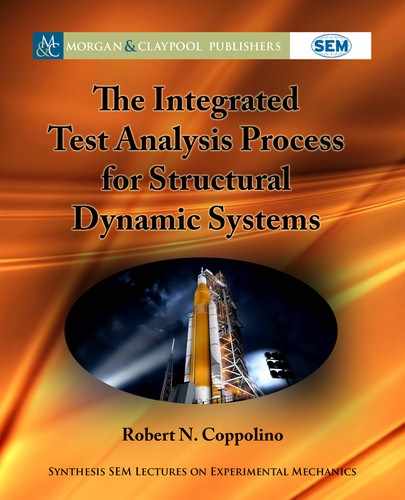
50 3. SYSTEMATIC MODAL TEST PLANNING
a. total boundary mass is a “row” matrix composed of diagonal terms of
Œ
M
0
bb
(see Equa-
tion (3.30));
b. modal effective mass (for mode, “n”) composed of diagonal terms of
Œ
Meff
bb
n
(see Equa-
tion (3.33)); and
c. normalized modal effective mass (for mode, “n”) is formed by the quotient
Œ
Meff
bb
n
=
Œ
M
0
bb
.
In the most general case of a structural dynamic model that has a redundant boundary
(typically more than 6 DOF), application of the above scheme may be difficult to interpret.
However, in most applications, the boundary is constrained to behave as a rigid body referenced
to a convenient grid location (6 DOF). In those situations, the total boundary mass conforms
to the system’s rigid body mass referenced at the selected grid location.
3.2.4 ILLUSTRATIVE EXAMPLE: ISS P5 SHORT SPACER
An evaluation of FEM modal content, including modal effective mass, was conducted with
results for the lowest 18 FEM modes summarized in Table 3.3.
Table 3.3: ISS P5 short spacer test article FEM modal kinetic energy and modal effective mass
Mode X Y X X Y Z ΘX ΘY ΘZTruss Grapple Fixture Comments
Modes with Modal Effective
Mass >5% are Colored Yellow
Modes with Non-negligible
Test Fixture KE
Colored Gray
Freq (Hz)
Directional KE (%) Directional KE (%) Modal Effective Mass (%) [restricted to Truss & Grapple]
Relying on modal effective mass, the target mode selection criterion (modal effective mass
> 5%) indicates that only five modes should have been judged “significant.” In the conduct of
the ISS P5 test program, the first 10 modes were selected as target modes on the basis of NASA’s
position that the dynamic environment cutoff for the Space Shuttle was f
D 35 Hz.
..................Content has been hidden....................
You can't read the all page of ebook, please click here login for view all page.
